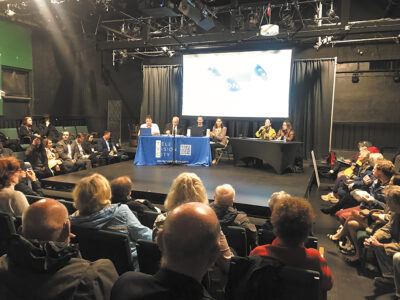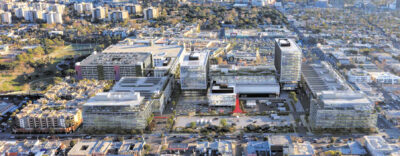Residents voice concerns with TVC Plan’s traffic and density
The Final Environmental Impact Report for the TVC 2050 Project proposed development at Television City was released by the Los Angeles City Planning Dept. on Nov. 21.

COMMUNITY meeting, held at Greenway Court Theater, was attended by developer project team members (at the table on the left), and Shelley Wagers and Danielle Peters of Neighbors for Responsible TVC Development, on the right.
“The Project would establish the TVC 2050 Specific Plan to allow for the continuation of an existing studio use and the modernization and expansion of media production facilities within the approximately 25-acre Television City studio,” according to the document, at tinyurl.com/7zaprzje.
Final EIR. What’s next?
With the release of the Final EIR as well as the Sign Plan and the Traffic Management Program, several public hearings will be scheduled, before votes by the City Planning Commission, City Council PLUM Committee, and the full City Council.
This follows a question-and-answer session Nov. 15 held by Neighbors for Responsible TVC Development. Co-chair Danielle Peters said at the outset, “Our group is not against this development. We support it.We support jobs. Our goal is to make this something that is livable.”
Several residents expressed concerns about the size and traffic impacts of the proposed development.
“This area is already at a critical mass with traffic, and the density with this project could tip the scales with the quality of life, where people will just go somewhere else,” said resident Aaron Hasson.
He lives near Beverly Boulevard and Fairfax Avenue, across from the studio, and he was among the many who came out on a rainy night and filled the 70-seat Greenway Court Theater at Fairfax High.
Brian Glodney, executive vice president of development and planning for developer Hackman Capital Partners, stated that the 70-year-old facility was visionary when CBS opened it in 1952. Hackman’s proposal is to modernize the facility, increasing it to a maximum of 1.85 million square feet of sound stages, production support, offices and other uses on the site. He was among four project team members at the meeting representing the developer.
Several residents expressed concern with the impacts of traffic (5,000 additional parking spaces are proposed on-site), and a request to change the land to Regional Center zoning.
Besides being twice the size of the “old Staples Center, it will bring thousands of commuters to the area,” Peters said.
“Upzoning to Regional Center will allow you to build much bigger than zoning allows for,” she added.
The Regional Center designation “doesn’t double the density. It brings the various land uses into modern land uses,” Glodney said.
“The development does not increase the 1.75 FAR (floor area ratio),” he added.
But Peters said the FAR could rise to that existing in Century City — a 6.1 FAR — if the site were sold to a new owner with the Regional Center zoning. “For the community, it’s the long game. It’s not just your property going forward.
“It could change the landscape of the neighborhood,” Peters said.
Glodney countered that a new owner would have to reapply with the city, hold public hearings and conduct additional environmental review to build more density than allowed. “They would need to ask the city to exceed the 1.75 FAR. That’s the fail-safe.”

TVC Today. Imagery ©2023 Google, Imagery ©2023 CNES / Airbus, Maxar
Technologies, U.S. Geological Survey, USDA/FPAC/GEO, Map data ©2023 Google

TVC Future concept. Image courtesy of Rios © 2021 Kilograph
Fifteen stories max
Glodney added, “[An] unlimited amount of height is allowed under current zoning.” Yet, the project’s Specific Plan imposes a maximum of 225 feet, or 15 stories, on the 25-acre property, he said.
“The height is less than eight percent of the project, and it’s far from the edges,” he added.
By contrast, one resident said the Park La Brea apartment towers are 150 feet high.
Another point of contention is that the developer seeks a construction agreement with the city allowing construction to be underway for a period of 32 months up to 20 years.
Glodney said Hackman Capital hoped the project could be built in 32 months, but if not, the project can be spaced out in five phases. It would not be 20 years of steady construction, he added.
“It’s very difficult for the community to have a project that is open-ended and deal with that level of uncertainty,” Neighbors for Responsible TVC Development Co-chair Shelley Wagers responded.
Emergency response times were also questioned by residents, as the local fire station, No. 61, is already shorthanded, a resident noted.
Others questioned how paramedics would be able to snarl through two-lane Fairfax Avenue with added traffic.
A Hackman representative said the Final EIR shows the fire services to be adequate.
Also alarming to residents was the number of projects — 66 — proposed for the surrounding area.
Developer transportation consultant Pat Gibson said only a few of those projects were in the works. “The six to seven major projects are going to be done by the time we start construction.”
The developer plans to close the site during the construction, keeping the staging on-site to minimize street traffic.
The finished project would include a Mobility Hub with employee shuttles to the subway and other sites.
The developer said a Sign District will keep digital signs on-site without visibility from the street. Alcohol use will be limited to 10 facilities on the site and two off-site. These and other measures are in the Final EIR, the project team said. But many attendees questioned the analysis and reports. “You don’t live here. You don’t know what it’s like to make an EIR a real document. They falsify. They don’t really tell the story of what it’s like to live here for decades,” one resident said.
Category: Real Estate
